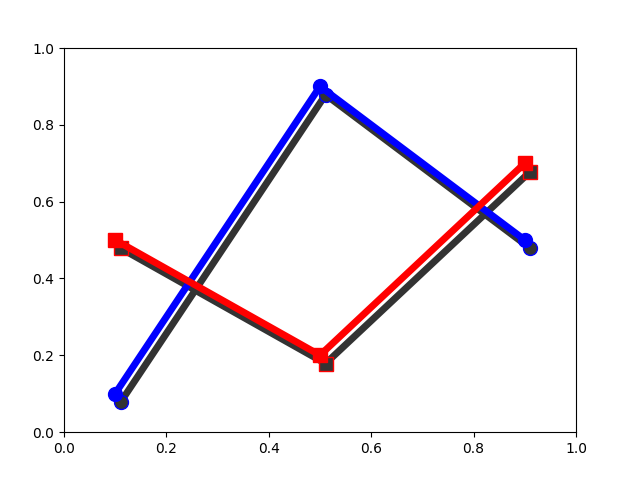Noter
Cliquez ici pour télécharger l'exemple de code complet
# de ligne de filtre SVG
Démontrez les effets de filtrage SVG qui pourraient être utilisés avec Matplotlib.
Notez que les effets de filtrage ne sont efficaces que si votre moteur de rendu SVG le prend en charge.

Saving 'svg_filter_line.svg'
import io
import xml.etree.ElementTree as ET
import matplotlib.pyplot as plt
import matplotlib.transforms as mtransforms
fig1 = plt.figure()
ax = fig1.add_axes([0.1, 0.1, 0.8, 0.8])
# draw lines
l1, = ax.plot([0.1, 0.5, 0.9], [0.1, 0.9, 0.5], "bo-",
mec="b", lw=5, ms=10, label="Line 1")
l2, = ax.plot([0.1, 0.5, 0.9], [0.5, 0.2, 0.7], "rs-",
mec="r", lw=5, ms=10, label="Line 2")
for l in [l1, l2]:
# draw shadows with same lines with slight offset and gray colors.
xx = l.get_xdata()
yy = l.get_ydata()
shadow, = ax.plot(xx, yy)
shadow.update_from(l)
# adjust color
shadow.set_color("0.2")
# adjust zorder of the shadow lines so that it is drawn below the
# original lines
shadow.set_zorder(l.get_zorder() - 0.5)
# offset transform
transform = mtransforms.offset_copy(l.get_transform(), fig1,
x=4.0, y=-6.0, units='points')
shadow.set_transform(transform)
# set the id for a later use
shadow.set_gid(l.get_label() + "_shadow")
ax.set_xlim(0., 1.)
ax.set_ylim(0., 1.)
# save the figure as a bytes string in the svg format.
f = io.BytesIO()
plt.savefig(f, format="svg")
# filter definition for a gaussian blur
filter_def = """
<defs xmlns='http://www.w3.org/2000/svg'
xmlns:xlink='http://www.w3.org/1999/xlink'>
<filter id='dropshadow' height='1.2' width='1.2'>
<feGaussianBlur result='blur' stdDeviation='3'/>
</filter>
</defs>
"""
# read in the saved svg
tree, xmlid = ET.XMLID(f.getvalue())
# insert the filter definition in the svg dom tree.
tree.insert(0, ET.XML(filter_def))
for l in [l1, l2]:
# pick up the svg element with given id
shadow = xmlid[l.get_label() + "_shadow"]
# apply shadow filter
shadow.set("filter", 'url(#dropshadow)')
fn = "svg_filter_line.svg"
print(f"Saving '{fn}'")
ET.ElementTree(tree).write(fn)